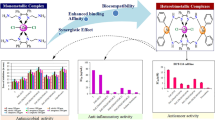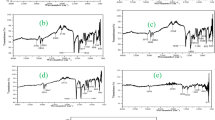Abstract
A new Schiff base ligand (HL) derived from quinoline-2-carboxaldehyde with 2-aminophenol (1:1 molar ratio) and its mixed ligand complexes, viz. 2,2′-bipyridine (1:1:1 molar ratio), have been synthesized and characterized by elemental analysis, spectroscopic studies, X-ray diffraction, ESR, magnetic and thermal analysis. The molar conductance measurement of mixed ligand complexes in DMF showed that Zn(II) and Cd(II) complexes were nonelectrolytes; however, Cr(III), Mn(II), Fe(III), Co(II), Ni(II) and Cu(II) complexes were electrolytes. The transition metal complexes had octahedral geometry with a general molecular formulae [M(L)(2,2′-bipy)(H2O)]Cl x ·nH2O (M = Cr(III) (x = n = 2), Mn(II) and Co(II) (x = 1, n = 0), Ni(II) and Cu(II) (x = n = 1) and [M(L)(2,2′-bipy)Cl]Cl x ·nH2O (M = Fe(III) (x = 1, n = 3), Zn(II) (x = 0, n = 1) and Cd(II) (x = 0, n = 2)). Also, Schiff base ligand and its mixed ligand complexes were screened against Gram-positive bacteria (Streptococcus pneumoniae, Bacillus subtilis), Gram-negative bacteria (Pseudomonas aeruginosa, Escherichia coli) and fungal species (Aspergillus fumigatus, Candida albicans). Gentamicin, ampicillin and amphotericin B were used as standard drugs for Gram positive, Gram negative and antifungal activity, respectively. The results showed that all mixed ligand complexes have antimicrobial activity higher than free Schiff base ligand. In addition, anticancer activity of Schiff base ligand and its mixed ligand metal complexes were also tested against breast cancer cell line (MCF-7) and colon cancer cell line (HCT-116). Cd(II) complex showed the highest IC50 against two cell lines.









Similar content being viewed by others
References
Mahmoud WH, Mahmoud NF, Mohamed GG, El-Sonbati AZ, El-Bindary AA. Synthesis, spectroscopic, thermogravimetric and antimicrobial studies of mixed ligands complexes. J Mol Struct. 2015;1095:15–25.
El-Sonbati AZ, Belal AAM, El-Gharib MS, Morgan S. Supramolecular structure, mixed ligands and substituents effect on the spectral studies of oxovanadium(IV) complexes of bioinorganic and medicinal relevance. Spectrochim Acta A. 2012;95:627–36.
Annaraj B, Balakrishnan C, Neelakantan MA. Synthesis, structure information, DNA/BSA binding affinity and in vitro cytotoxic studies of mixed ligand copper(II) complexes containing a phenylalanine derivative and diimine co-ligands. J Photochem Photobiol B. 2016;160:278–91.
Neelaeni R, Vasantha S, Keerthana R, Sivakolunthu S, Angeline T. DNA cleavage activity of novel schiff base copper(II) complexes with sulfur containing-ligand (2-(2-methyl-thio)phenylimino)methylphenol, N-benzylidine-2-methylthioaniline. Asian J Pharm Clin Res. 2016;9:277–81.
Kudrat-E-Zahan M, Alim Abdul M, Haque MM, Lokonuzzaman A, Sher AM, Saiidul IM. Studies on the mixed ligand complexes of Co(II), Ni(II) and Cu(II) with phthalimide and heterocyclic amines. Int J Mater Sci Appl. 2015;4:120–3.
Melinmath SP, Venkatesh KB, Rekha ND, AshaIyengar T. Mononuclear mixed ligand transition metal complexes: synthesis, characterization, antioxidant and antimicrobial activity along with DNA cleavage studies. IAJPR. 2015;5:2503–11.
Creaven BS, Devereux M, Foltyn A, McClean S, Rosair G, Thangella VR, Walsh M. Quinolin-2(1H)-one-triazole derived Schiff bases and their Cu(II) and Zn(II) complexes: possible new therapeutic agents. Polyhedron. 2010;29:813–22.
Marcaccino S, Pepino R, Pozo MC, Basurto S, Garia-valverde M, Torroba T. One-pot synthesis of quinolin-2-(1H)-ones via tandem Ugi-Knoevenagel condensations. Tetrahedron Lett. 2004;45:3999–4001.
Kulkarni NV, Hegde GS, Kurdekar GS, Budagumpi S, Sathisha MP, Revankar VK. Spectroscopy, electrochemistry and structure of 3d-transition metal complexes of thiosemicarbazones with quinoline core: evaluation of antimicrobial property. Int J Rapid Commun. 2010;43:235–46.
Sudha N, Selvi G. Synthesis, characterization and biological studies on Fe(II) and Zn(II) quinoline Schiff Base complexes. Int J Chem Tech Res. 2015;8:367–74.
Solomon VR, Lee H. Quinoline as a privileged scaffold in cancer drug discovery. Curr Med Chem. 2011;18:1488–508.
Bentzinger G, De SW, Mullié C, Agnamey P, Dassonville-Klimpt A, Sonnet P. Asymmetric synthesis of new antimalarial aminoquinolines through Sharpless aminohydroxylation. Tetrahedron Asymmetry. 2016;27:1–11.
Anantacharya R, Manjulatha K, Satyanarayan ND, Santoshkumar S, Kaviraj MY. Antiproliferative, DNA cleavage, and ADMET study of substituted 2-(1-benzofuran-2-yl) quinoline-4-carboxylic acid and its esters. Cogent Chem. 2016;2:2016. doi:10.1080/23312009.1158382.
Nkoana W, Nyoni D, Chellan P, Stringer T, Taylor D, Smith PJ, Hutton AT, Smith GS. Heterometallic half-sandwich complexes containing a ferrocenyl motif: synthesis, molecular structure, electrochemistry and antiplasmodial evaluation. J Organomet Chem. 2014;752:67–75.
Maddela S, Makulaa A, Maddela R. Synthesis of isatin-quinoline conjugates as possible biologically active agents. Toxicol Environ Chem. 2014;96:1–11.
Muruganantham N, Sivakumar R, Anbalagan N, Gunasekaran V, Leonard JT. Synthesis, anticonvulsant and antihypertensive activities of 8-substituted quinoline derivatives. Biol Pharm Bull. 2004;2:1683–7.
Shinkai H, Ito T, Ida T, Kitao Y, Yamadu H, Uchida I. 4-Aminoquinolines: novel nociceptin antagonists with analgesic activity. J Med Chem. 2000;43:4667–77.
Papageorgion C, Matt AV, Joergensen J, Anderson E, Wagner K, Beerli C, Than T, Borex X, Florineth A, Rihs S, Schreier MH, Weckbecker G, Hausser C. Aromatic quinolinecarboxamides as selective, orally active antibody production inhibitors for prevention of acute xenograft rejection. J Med Chem 2001;44:1986–92.
Pascual-Àlvarez A, Topala T, Estevan F, Sanz F, Alzuet-Piña G. Photoinduced and self-activated nuclease activity of copper(II) complexes with N-(Quinolin-8-yl)quinolin-8-sulfonamide—DNA and bovine serum albumin binding. Eur J Inorg Chem. 2016;7:982–94.
Mruthyunjayasswamy BHM, Vivekanand DB, Mahenra RK. Synthesis, characterization and DNA cleavage studies of some transition metal complexes derived from 5-chloro-3-phenyl-N′(tetrazolo[1,5-a]quinolin-4-ylmethylene)-1H-indole-2-carbohydrazide. Res J Pharm Biol Chem Sci. 2014;5:1057–70.
Mistry BM, Jauhari S. Synthesis and evaluation of some quinoline Schiff bases as a corrosion inhibitor for mild steel in 1 N HCl. Res Chem Intermed. 2013;39:1049–68.
Veledo MT, Pelaez-Lorenzo C, Gonzalez R, de Frutos M, Diez-Masa JC. Protein fingerprinting of Staphylococcus species by capillary electrophoresis with on-capillary derivatization and laser-induced fluorescence detection. Anal Chim Acta. 2010;658:81–6.
Sarmah PP, Deb B, Borah BJ, Fuller AL, Slawin AMZ, Woollins JD, Dutta DK. Rhodium(I) carbonyl complexes of quinoline carboxaldehyde ligands and their catalytic carbonylation reaction. J Organomet Chem. 2010;695:2603–8.
Qin J, Li T, Wang B, Yang Z, Fan L. A sensor for selective detection of Al3+ based on quinoline Schiff-base in aqueous media. Synth Met. 2014;195:141–6.
Flaschka HA. EDTA titration. 2nd ed. New York: Pergamon Press; 1964. p. 81–6.
Vogel AI. Textbook of quantitative inorganic analysis. 4th ed. London: Longman; 1978.
West TS. Complexometry with EDTA and related reagents. 3rd ed. Pools: DBH Ltd.; 1969.
Scott AC. Laboratory control of antimicrobial therapy. In: Collee JG, et al., editors. Practical medical microbiology. 13th ed. Edinburgh: Churchill Livingstone; 1989. p. 161–81.
Mosmann T. Rapid colorimetric assay for cellular growth and survival: application to proliferation and cytotoxicity assays. J Immunol Methods. 1993;65:55–63.
Abd El-Halim HF, Mohamed GG, El-Dessouky MM, Mahmoud WH. Ligational behaviour of lomefloxacin drug towards Cr(III), Mn(II), Fe(III), Co(II), Ni(II), Cu(II), Zn(II), Th(IV) and UO2(VI) ions: synthesis, structural characterization and biological activity studies. Spectrochim Acta Part A. 2011;82:8–19.
Mahmoud WH, Mohamed GG, El-Dessouky MM. Synthesis, characterization and in vitro biological activity of mixed transition metal complexes of lornoxicam with 1,10-phenanthroline. Int J Electrochem Sci. 2014;9:415–38.
Mohamed GG, Soliman MH. Synthesis, spectroscopic and thermal characterization of sulpiride complexes of iron, manganese, copper, cobalt, nickel, and zinc salts. Antibacterial and antifungal activity. Spectrochim Acta Part A. 2010;76:341–7.
Wei Q, Dong J, Zhao P, Li M, Cheng F, Kong J, Li L. DNA binding, BSA interaction and SOD activity of two new nickel(II) complexes with glutamine Schiff base ligands. J Photochem Photobiol B Biol. 2016;161:355–67.
Abd El-Halim HF, Mohamed GG. Synthesis, spectroscopic studies, thermal analyses, biological activity of tridentate coordinated transition metal complexes of bi(pyridyl-2-ylmethyl)amine]ligand. J Mol Struct. 2015;1104:91–5.
Meenongwa A, Brissos RF, Soikum C, Chaveerach P, Gamez P, Trongpaniche Y, Chaveerach U. Effects of N, N-heterocyclic ligands on the in vitro cytotoxicity and DNA interactions of copper(II) chloride complexes from amidino-O-methylurea ligands. New J Chem. 2016;40:5861–76.
Reddy PR, Shilpa A. Oxidative and hydrolytic DNA cleavage by Cu(II) complexes of salicylidene tyrosine schiff base and 1,10-phenanthroline/bipyridine. Polyhedron. 2011;30:565–72.
Sheikhshoaie I, Ebrahimipour SY, Lotfi N, Mague JT, Khaleghi M. Synthesis, spectral characterization, X-ray crystal structure and antimicrobial activities of two cis dioxido-vanadium(V) complexes incorporating unsymmetrical dimalonitrile-based (NNO) Schiff base ligands. Inorg Chim Acta. 2016;442:151–7.
Soliman MH, Hindy AM, Mohamed GG. Thermal decomposition and biological activity studies of some transition metal complexes derived from mixed ligands sparfloxacin and glycine. J Therm Anal Calorim. 2014;115:987–1001.
Kivelson D, Meiman R. ESR studies on the bonding in copper complexes. J Chem Phys. 1961;35:149–55.
Chandra S, Sangeetika X. EPR, magnetic and spectral studies of copper(II) and nickel(II) complexes of schiff base macrocyclic ligand derived from thiosemicarbazide and glyoxal. Spectrochim Acta Part A. 2004;60:147–53.
Hathaway BJ. D.E. Billing DE. The electronic properties and stereochemistry of mono-nuclear complexes of cu(II) ion. Chem Rev. 1970;5:143–207.
El-Sonbati AZ, Diab MA, El-Bindary AA, Mohamed GG, Morgan SM. Thermal, spectroscopic studies and hydrogen bonding in supramolecular assembly of azo rhodanine complexes. Inorg Chim. 2015;430:96–107.
El-Ghamaz NA, El-Sonbati AZ, Diab MA, El-Bindary AA, Mohamed GG, Morgan SM. Correlation between ionic radii and of metal azodye complexes and electrical conductivity. Spectrochim Acta A. 2015;147:200–11.
Velumania S, Mathew X, Sebatain PJ, Narayandass SK, Managlaraj D. Structural and optical properties of hot wall deposited CdSe thin films. Sol Energy Mater Sol Cells. 2003;76:347–58.
Sasavaraja S, Salaji DS, Bedre MD, Raghunandan D, Swamy PM, Venkatarmam A. Solvo-thermal synthesis and characterization of acicular α-Fe2O3 nanoparticles. Bull Mater Sci. 2011;34:1313–7.
El-Sonbati AZ, El-Bindary AA, Mohamed GG, Morgan SM, Hassan WM, Elkholy AK. Geometrical structures, thermal properties and antimicrobial activity studies of azodye complexes. J Mol Liquids. 2016;218:16–34.
Abd El-Halim HF, Nour El-Dien FA, Mohamed GG, Mohamed NA. Synthesis, spectroscopic, thermal characterization and antimicrobial activity of miconazole drug and its metal complexes. J Therm Anal Calorim. 2012;109:883–92.
Pelczar MJ, Chan ECS, Krieg NR. Host–parasite interaction; nonspecific host resistance. In: Microbiology concepts and applications, 6th ed. New York: McGraw-Hill Inc.; 1999, p. 478–9.
Prescott LM, Harley JP, Klien DA. Microbiology, 2nd ed. Wm. C. Brown Communications, Inc.; 1993.
Author information
Authors and Affiliations
Corresponding author
Electronic supplementary material
Below is the link to the electronic supplementary material.
Rights and permissions
About this article
Cite this article
Abd El-Halim, H.F., Omar, M.M. & Anwar, M.N. Preparation, characterization, antimicrobial and anticancer activities of Schiff base mixed ligand complexes. J Therm Anal Calorim 130, 1069–1083 (2017). https://doi.org/10.1007/s10973-017-6491-1
Received:
Accepted:
Published:
Issue Date:
DOI: https://doi.org/10.1007/s10973-017-6491-1




